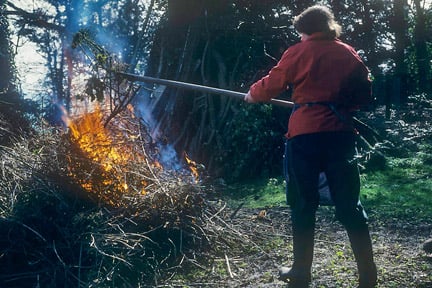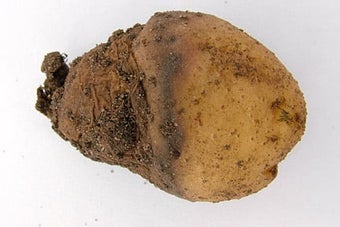
Quick facts
Suitable for - All plant material
Timing - Throughout the year
Difficulty - Easy
Suitable for...
These techniques are suitable for herbaceous and woody material, , and .
How to reduce disease spread
Fungal, bacterial and viral diseases (pathogens) can be spread by air currents, rain droplets, soil, seeds, insects and mammals, transporting plants and through physical injury such as pruning.
Most pathogens can survive on dead plant material and some can also survive on their own in the soil or on surfaces in greenhouses and on tools, making very important.
To reduce problems:
- Remove infected leaves from herbaceous plants and vegetables as soon as they are spotted
- Prune woody plants in dry conditions and, in the case of Prunus, only in summer when fungal diseases such as silver leaf are least prevalent
- Disinfect tools with a garden disinfectant (used as directed by the manufacturers) after pruning material affected by viruses and other pathogens carried in , such as bacterial canker
- Avoid spreading soil-borne diseases such as club root, Phytophthora root rot or honey fungus by cleaning boots, tools and equipment after digging, working or walking on contaminated soil. In such cases, don't move soil round the garden
- Ensure all infected leaves of plants, such as roses with black spot, are gathered up in winter and disposed of before vulnerable new growth emerges
- Mulch around the base of shrubs in early spring to bury remaining spores
- Remove stumps and roots of trees affected by root diseases such as honey fungus. Where digging out is not possible, stump grinding should be undertaken and the grindings should be collected up and sent to landfill
- Remove weeds that can act as a reservoir for infection; groundsel hosts some leaf rusts, for example
- Clean greenhouses, tools, pots and trays thoroughly in winter, to reduce problems such as damping off
How to dispose of diseased material
It will be necessary to use a range of disposal methods, depending on the type of material and the disease:
- Home
Although bins rarely reach temperatures sufficient for killing pathogens, they are suitable for disposing of material infected by some less-persistent diseases. Common foliar fungal diseases such as powdery mildews and rusts can not usually survive for long once the plant material has fully degraded. This is especially true if the infection has been caught early, before the pathogen has had time to produce resilient spores or structures -
Council composting facilities should reach temperatures capable of killing most diseases. Although transport and collection makes this option less sustainable than home-composting, many gardeners may be more comfortable sending infected material out of the garden. Some councils vary in what they are prepared to accept – thick branches and large volumes of rotten fruit may not be, for example. If in doubt, check with your local authority - Burial
This is a simple, sustainable way of handling some diseased material on site; for example, leaves infected with foliar diseases such as black spot and fruit suffering from rots such as brown rot. Find a site in bare ground between shrubs or in a vegetable garden and bury material at least 30cm (1ft) deep so that it will not be unearthed by cultivation or mammals. Do not bury material infected by soil-borne diseases such as club root and sclerotinia or any woody material that will be slow to break down - Bonfires
Dry, woody material can be burnt in gardens that are large enough to have a safe bonfire or incinerator. This is ideal for branches affected by canker and fireblight and for woody roots infected with honey fungus. Traditionally, annual autumn bonfires would have been the way of disposing of uncompostable material, but do bear in mind that leaving diseased material stacked until bonfire night can be unhygienic. Bonfires create pollution and may also annoy neighbours. They should be conducted when wind and weather mean that smoke will not enter houses or inhibit others from enjoying their garden. Here are some government guidelines on bonfires in smoke control areas. - Household waste
Plant material such as rotten and tubers, collapsed in contaminated compost and small woody prunings can be thrown away in the household waste. From here they will be sent to landfill sites to be buried deeply in a lined and sealed environment. Consider this only when other methods are not appropriate, as landfill space is in short supply and material in landfill releases methane (a greenhouse gas contributing to climate change) - Council refuse site
Where burning is not possible, woody material and rootballs may need to be taken to the tip/recycling centre. It is a requirement to deposit these with general waste as they are usually too large for shredding for compost
Further reading
For help with identifying diseases read:
RHS Pests and Diseases by Pippa Greenwood and Andrew Halstead (Dorling Kindersley 2009, ISBN 9781405341776)
Pests, Diseases and Disorders by Stefan Buczacki and Keith Harris (Collins 2005, ISBN 9780007196821)
These books are also made available through the RHS Lindley Library.



